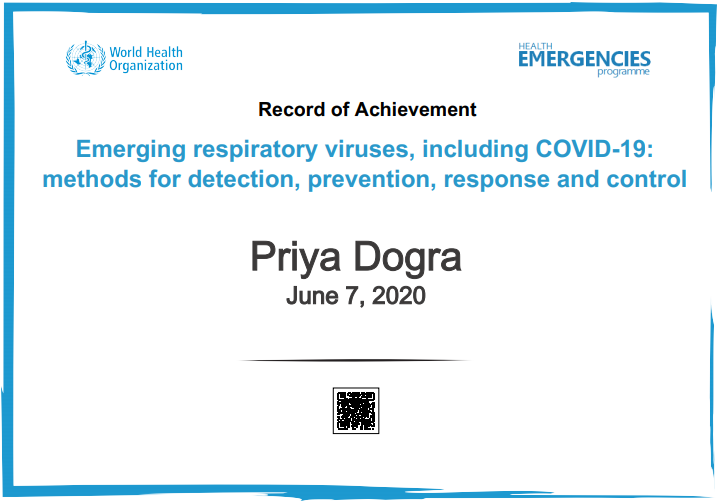
Coronaviruses are a wide family of viruses believed to cause disease ranging from mild cold to more serious infections such as Middle East Respiratory Syndrome (MERS) and Severe Acute Respiratory Syndrome (SARS).
In 2019 a novel coronavirus (COVID-19) was discovered in Wuhan , China. It is a modern coronavirus that was not identified in humans beforehand.
This course includes a general guide to COVID-19 and new respiratory viruses and is designed for specialists in public health, emergency management and workers working with the UN, foreign organisations and NGOs.
Apply Here: FREE WHO CERTIFICATE
Question 1: Zoonotic diseases are:
- Diseases that have a mortality rate of greater than 50%.
- Diseases that have appeared in a population for the first time.
- Diseases that are naturally transmitted between vertebrate animals and humans.
- Diseases that are caused by bacteria.
Question 2: The percentage of emerging and re-emerging infectious diseases that are of zoonotic origin is estimated to be:
- 10-20%
- 100%
- 70-80%
- 40-50%
Question 3: A spillover event is:
- When a pathogen’s geographic range extends from one country to another.
- The worldwide spread of a new disease.
- When a pathogen that is circulating in an animal species is found to be transmitted to humans.
- An extraordinary event which is determined to constitute a public health risk to other states through the international spread of disease.
Question 4: True or False: Coronaviruses can be transmitted from person to person.
- True
- False
Question 5: Which of the following are measures to protect yourself and others against coronavirus infection? (Select all that apply)
- Avoiding direct unprotected contact with live animals.Correct!
- Coughing and sneezing without covering your nose or mouth.
- Covering nose and mouth when coughing or sneezing.Correct Answer
- Washing hands regularly.
Module B
Question 1: Which of the following is an example of active case finding?
- Collecting demographic information of all confirmed cases to identify risk factors.
- Actively searching for cases in healthcare facilities where infected patients were cared for. Reviewing clinical characteristics of confirmed cases.
- Creating an epidemic curve to track the progress of the outbreak
Question 2: From the evidence that is currently available, how long do contacts of a confirmed case need to be monitored if they have no symptoms?
- 7 days
- 28 days
- 14
- 3 weeks
Module B2: Quiz
Question 1: True or False: If a negative test result is obtained from a patient with a high index of suspicion for infection, new specimens should be collected and tested.
- True
- False
Question 2: A negative test result can be obtained even if an individual is infected because of the following reason/s:
- The specimen was collected late or very early in the illness.
- The specimen was of poor quality.
- The specimen was not handled or shipped appropriately.
- All of the above.
Question 3: True or False: Outbreak investigations require a multidisciplinary team.
- True
- False
Question 4: Which of the following are key components in the descriptive analysis of cases? (Select all that apply)
- Place
- Income
- TimeCorrect!
- Person
Module C1: Quiz
Question 1: True or False: Cultural and traditional practices may sometimes be a barrier to the uptake of health advice.
- True
- False
Question 2: Which of the following are good risk communication approaches? (Select all that apply)
- Develop health messages in only one major language in order to keep the message consistent and trusted.
- In an outbreak where knowledge about the virus is evolving, health advice must be stated with appropriate uncertainty
- Health messaging should be consistent across several channels
- Health messages should be tailored to the target audience
Question 3: True or False: Rumour surveillance is not important during an outbreak if health authorities provide accurate health information regularly.
- True
- False
Question 1: Key reasons that responders need to engage communities during an outbreak are: (Select all that apply)
- Response teams need to know how communities understand the disease and the response.
- Generic public or media announcements are not sufficient, trusted or tailored to communities at high-risk
- Engaging with communities allows their direct participation in the response to address fears, barriers and concerns
- It will increase community donations to fund the health response.
Question 2: True or False. Communication involves sending and receiving information.
- True
- False
Question 1: True or False: When triaging patients at health care facilities, masks are required only for patients with a confirmed infection.
- True
- False Correct
Question 2: What type of infection control precautions are required when performing an aerosol-generating procedure, such as bronchoscopy, on a patient with suspected or confirmed illness? (Select all that apply)
- Contact precautions
- Airborne precautions
- Droplet precautions
- No precautions are required if the procedure is done carefully.
 Priya Dogra – Certification | Jobs | Internships
Priya Dogra – Certification | Jobs | Internships



thanks got the free govt certificate